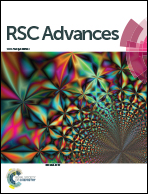Synthesis and characterization of novel 4-phenyl-pyridine unit based alkaline anion exchange membranes†
Abstract
For exploring more types of suitable polymeric membranes for application in alkaline fuel cells (AFCs), a series of 1,2-dimethylimidazolium functionalized poly(arylene ether sulfone)s containing 4-phenyl-pyridine units in the main chain (named as DIm-PPYPAES) were firstly synthesized as anion exchange membranes (AEMs) in this work. Proton nuclear magnetic resonance (1H NMR) and Fourier transform infrared (FT-IR) spectroscopy were employed to characterize and confirm the chemical structure of the synthesized copolymers and the derived membranes. The DIm-PPYPAES membranes with different ionized levels ranging from 1.15 meq. g−1 to 1.77 meq. g−1, exhibited good thermal stability, solubility behavior and a relatively high level of hydroxide conductivity. The highest hydroxide conductivity of 83.35 mS cm−1 at 80 °C was achieved for the DIm-PPYPAES-4 membrane with a moderate IEC of 1.77 meq. g−1. Moreover, after 15 days of treatment with a 2 M NaOH solution at 60 °C, the DIm-PPYPAES membrane still exhibited relatively high ionic conductivity even above 10 mS cm−1 at 30 °C and retained their integrated shapes.


 Please wait while we load your content...
Please wait while we load your content...